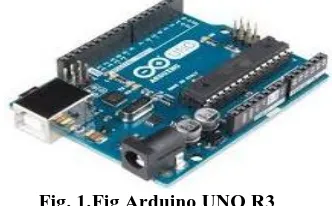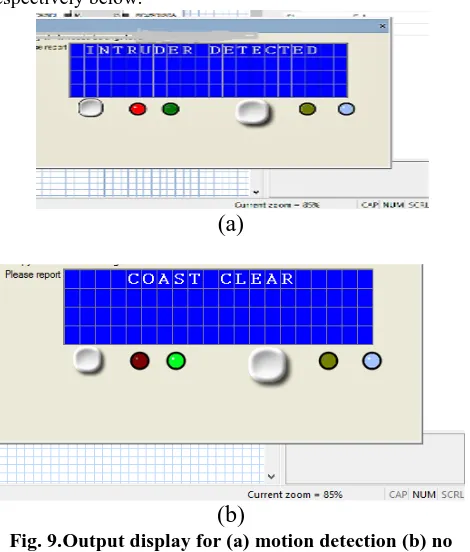International Journal of Innovative Technology and Exploring Engineering (IJITEE) ISSN: 2278-3075,Volume-8 Issue-12, October 2019
Abstract:The use of smartphone technology as a tool for communication is ever-increasing, and this technology shows no sign of decline. Moreover, since the era of social networking, smartphones have become a significant entity that humans cannot do without. Internet of things has now opened a new era where we can keep contact data, surf the internet, exchange messages, take notes, carry files and documents, etc. Besides, we can now control hardware like lights, fans, air conditioners, etc.
This research aims at designing home security systems to keep selected space safe from intruders and detect gas leakage. The methodology integrated GSM module, ultrasonic sensor, Passive Infrared Sensor (PIR), and gas detectors to implement the wireless remote home security technology. This system adopts the Global System for Mobile Communication (GSM) technology for optimal functionality and is programmed to respond rapidly as intrusion or gas leakage is detected. The GSM module alerts the homeowner via phone call.
Keywords:Arduino, Global system for mobile, Smart Home, Security.
I. INTRODUCTION
Concerns about security, in general, grow continually, as well as the study to address these concerns. Several intrusion detections prototypes have been developed. While some aim at preventing intrusions such as systems used in classified facilities or banks, others are just built for detection [1]. Although some techniques are more reliable than others, it is always at the expense of cost [2].
The web-based security system and hardware-based system are often made of fancy designs and feature high prices throughout shelves of malls. This implies that commoners, in most cases, cannot afford this equipment. Hence, phone-based technology was adopted to make use of the GSM module with Arduino Uno.
This system is designed with the convenience of installation, safety, and cost in mind, which necessitated the below-listed components:
Infrared sensor (PIR)
Ultrasonic sensor
GSM module
Flame detection unit
Revised Manuscript Received on October 05, 2019.
Peter Oyekola, Mechanical Engineering department,Papua New Guinea University of Technology, Lae, Papua New Guinea.Petertosin@gmail.com
TaiwoOyewo, Computer Engineering department, Bells University of Technology, Ogun, Nigeria.tealkyy@gmail.com
Abigail Oyekola, Electrical Engineering department, Auckland University of Technology, Auckland, New Zealand.kxg9420@autuni.ac.nz
Aezeden Mohamed*, Mechanical Engineering department, Papua New Guinea University of Technology, Lae, Papua New Guinea. aezeden.mohamed@png.ac.pg
Modern security detection and monitoring systems can be synchronized and designed to alert owners of threats. This complete monitoring and detection is achieved by fusing the compact system to prevent a diversity of operation and high cost of purchasing individual systems [3].
II. COMPONENTDESCRIPTION A. Microcontroller (ATmega328)
[image:1.595.348.514.435.538.2]AVR microcontrollers (Advanced Virtual RISC), are electronic circuits that can be automated to carry out several tasks. The preferred controller was an 8-bit based microcontroller combining thirty-two kilobyte flash memory for code execution, internal and external interrupts, serial programmable USART, serial interface, serial port interface and 6-channel 10-bit A/D converter (8-channels in TQFP and QFN/MLF packages) [4] [5], also, its functionalities include configurable watchdog timer which can reset when errors are encountered and for use with minimum human interference, inbuilt oscillator and different power saving modes (1.8-5.5 volts) [6] [7] these modes ensures functionality on mobile embedded systems.
Fig. 1.Fig Arduino UNO R3 B. PIR Sensor
This sensor detects human motion within roughly 10m from the sensor position. PIR is made of pyroelectric sensors which can be used in detecting certain levels of infrared radiation [8]. This sensor also senses motion in darkness due to a high signal on the input-output pin [9].
Fig. 2.PIR sensor
Arduino Based Smart Home Security System
C. Ultrasonic Sensor
[image:2.595.106.238.143.236.2]The ultrasonic sensor measures distance to an object with the aid of sound waves. It outputs sound waves at a specific frequency and inputs the return echo that bounces of obstacles. The travel time of the generated sound wave can then be estimated mathematically, after which, the estimated travel time is used to estimate the distance to the object.
Fig. 3.HC-SR04 ultrasonic module
D. GSM SIM 900
[image:2.595.365.502.158.248.2]SIMCom is a compact wireless module embedded with complete Quad-band GSM and position recording. It is designed with AMR926EJ-S core single-chip processor, which makes it sturdy and capable of swift processing [10]. It is a compact and cost-effective module that requires a subscriber identity module to be used in establishing communication with the system. The GSM/GPRS modem can send, receive, and has the capability of modifying SMS messages such as read, add, search phonebook entries, place, accept, or reject calls [11].
Fig. 4.SIM 900 module
E. Gas sensor
The MQ series sensors were selected to aid in the detection of gas due to their sensitivity for several gasses which can be present indoor at room temperature. The analog output the signal is read with the analog input of the microcontroller.
The internal resistance, however, depends on the type of gas present, but the inbuilt potentiometer can be used to calibrate the sensors to the desired accuracy properly.
Fig. 5.Gas sensor module
F. Display Unit
For this project, the 16×2 Character LCD is used. It is a universal module often used in Arduino based projects as it contains two rows capable of outputting sixteen characters with characters displayed in a 5×7 format. The design structure also makes it easy to interface with microcontrollers [12].
[image:2.595.101.249.398.508.2]16 X 2 LCD display
[image:2.595.90.509.545.720.2]International Journal of Innovative Technology and Exploring Engineering (IJITEE) ISSN: 2278-3075,Volume-8 Issue-12, October 2019
III. SYSTEMDESCRIPTION
Thisnetwork integrates both hardware and software components with the hardware consisting of an embedded system based on Arduino microcontroller (ATmega328) [4], mobile phone with GSM Module (SIM900) as well as the various sensors listed in the description of the components. Flowcode v5 and the Arduino development environment [13] are used in the software design of this system. The Flowcode was used to program the sensors while the Arduino was used to configure the operation of the GSM module. The working principle behind the detection of smoke was based using a more sensitive detection system such as the First Alert 7010B Hardwired Photoelectric Smoke Alarm system to detect wide rangeof smoke particles or even simmer type of fire as calibrated [14].
A. Arduino code
#include <TimerOne.h>
#include <LiquidCrystal.h>
#include <SoftwareSerial.h>
SoftwareSerial cell(2, 3);
LiquidCrystal lcd(A0, A1, A2, A3, A4, A5);
const int trigPin = 5;
const int echoPin = 6;
const int pir = 7;
char inchar, state, callActive;
long duration, inches, cm, cnt, cnt2, callDelay;
void setup(){
pinMode(trigPin, OUTPUT); pinMode(echoPin,
INPUT);
pinMode(pir, INPUT);
cell.begin(19200);
Serial.begin(19200);
lcd.begin(16,2); lcd.clear();
delay(7000);
// turn on caller ID notification
cell.print("AT+CLIP=1\r"); delay(100);
Timer1.initialize(5000); //5ms
Timer1.attachInterrupt(LD);
}
void getDistance(){
digitalWrite(trigPin, LOW); delayMicroseconds(2);
digitalWrite(trigPin, HIGH);
delayMicroseconds(10);
digitalWrite(trigPin, LOW);
duration = pulseIn(echoPin, HIGH);
cm = duration / 29 / 2; inches = duration / 74 / 2;
}
void LD(){
cnt++;
if(cnt>=200){
cnt=0; cnt2++; callDelay++; getDistance();
//Serial.println(cm);
if((callActive==1) && (callDelay==30))
cell.println("ATH"); // hang up
else if((callActive==1) && (callDelay==60)){
callDelay = 0; callActive = 0;
}
if(cnt2>=4){
lcd.setCursor(0,0); lcd.print("INTRUDER
SENSOR "); cnt2 = 0;
}
}
}
void callSomeone(){
cell.println("ATD + +234**********;");
delay(100);
cell.println(); callActive = 1; callDelay = 0;
}
void loop(){
char inchar=0;
if(cell.available() > 0){
delay(10); inchar=cell.read(); Serial.print(inchar);
}
if((state==1) && (callActive==0)) callSomeone();
if((digitalRead(pir)==HIGH) && (cnt2<2)){
lcd.setCursor(0,1); lcd.print("Intruder Detected");
}
else if((cm<200) && (cnt2<4)){ //state = 0;
lcd.setCursor(0,1); lcd.print(cm); lcd.print("cm
from Door "); state = 1;
}
else state = 0;
}
[image:3.595.307.553.643.728.2]The GSM module has three pins: The ground pin, receive pin and the transmit pin. The Receive and Transmit pins are used in the transmission and receiving of serial data [15]. The Phone call communication between the mobile phone and the GSM module is controlled by sending AT commands serially to the module [16] [11]. The USART serial input pin RX (pin 26) and TX (pin 25) of the microcontroller [11] are connected to the TXD and RXD pins of the GSM Modem respectively. For microcontroller interaction with the GSM module, the USART peripheral of the microcontroller is activated. The USART was organized as a full-duplex non-concurrentframework to interface with outside gadgets like the A/D or D/An incorporated circuit, sequential EEPROMs[15] [16]. For this undertaking, the USART is utilized as a half-duplex synchronous framework [11]. It communicates with the Analog-to-Digital converter using a discrete sign of 1 by changing over the yield simple sign of the PIR sensor to trigger the transmission of the Phone call to the framework client [8].
The essential NPN transistor hypothesis was executed in the circuit [14]. The smoke detection system functioned using the NPN transistor type immersion of authority based on a one-sidedintersection, and the base-producer intersection turned around forward-one-sided. Therefore, there is a high 5V of the microcontroller board at stick 10, which associated with the base.The transistor itself works in an immersion locale of the DC burden line, and all things considered, it turns into a conductor and potential is built up over the transfer which activates it. The invert occurs where a low signal of the microcontroller is sent.This causes the base-producer intersection to progress around one-side,and the gather base intersection is additionally switched (normal producer setup transistor).This indicates that the transistor is working at the cut off region. The transistor Q1 will work as an open circuit;hence the ringers will stay off.
Fig. 8.Smoke detection circuit diagram
IV. RESULTSANDANALYSIS
The program for the PIR sensor was simulated with Flowcode V5 and the output when an intruder is detected (when the PIR output pin goes high) and when no intruder is detected (when the PIR output pin goes low) is shown respectively below.
(a)
(b)
Fig. 9.Output display for (a) motion detection (b) no motion detected
The PIR sensor code was changed to detect only human
of coverage of the PIR.
This prevents the accidental triggering of the system when pets are within range of the sensors.
In the absence of smoke, the Red LED stayed OFF while the Green LED was ON. When there is smoke the Red LEDs will blink; the Green LED switched OFF while the GSM module communicates with the owner via SMS.
The Voltage regulator 78L05 as selected for effective power-saving.
V. CONCLUSION
In this paper, we discussed GSM based home security system that provides a simple and easy way of detecting intrusion. The PIR sensor has been introduced and implemented in the design of this project. The UART communication between the hardware and the user of this system has been successfully established. The transmission of the phone calls is dependent on the state of the sensors. From the test conducted, the user gets real-time alerts through the technology employed, thereby making the system localization genuinely independent.
VI. REFERENCES
A. Oludele, O. Ayodele, O. Oladele and S. Olurotimi,
“Design of an Automated Intrusion Detection System incorporating an Alarm,” JOURNAL OF COMPUTING,, vol. 1, no. 2151-9617, 2009.
2. W. . Easttom, “Computer Security Fundamentals,” , 2005. [Online]. Available:
https://amazon.com/computer-security-fundamentals-cybersecurity-cur riculum/dp/078975746x. [Accessed 29 6 2019].
3. E. Hinderliter, “Allied Universal,” 2015. [Online]. Available: https://www.aus.com/blog/integrated-fire-and-intrusion-alarm-systems-help-save-lives-and-assets. [Accessed May 2017].
4. ELECTRONICS HUB, “Microcontroller Types and Applications,” 9
August 2015. [Online]. Available:
https://www.electronicshub.org/microcontrollers/. [Accessed 18 May 2017].
5. J. A, “ Circuits, Programs & Applications Featuring the.8052-BASIC Single-Chip Computer,” in The Microcontroller Idea Book, Lakeview Research, 1994.
6. Microchip, “ATmega328P,” Microchip, [Online]. Available: https://www.microchip.com/wwwproducts/en/atmega328p. [Accessed 17 June 2017].
7. Y. W. Bai and Y. T. Ku, “Automatic room light intensity detection and control using a microprocessor and light sensors,” IEEE Transactions on Consumer Electronics, vol. 54(3), no. 1173-1176, 2008.
8. S. Nahatkar, A. Gaur and T. M. Pattewar, “Design of a Home Embedded Surveillance System with Pyroelectric Infrared Sensor & Ultra-Low Alert Power,” International Journal of Advanced Research in Electronics and Communication Engineering , vol. 1, no. 3, 2012. 9. Q. Hao, F. Hu and Y. Xiao, “Multiple human tracking and identification
with wireless distributed pyroelectric sensor systems,” IEEE Systems Journal, vol. 3(4), no. 428-439, 2009.
10. N. Agnihotri, 2010. [Online]. Available:
https://www.engineersgarage.com/articles/gsm-gprs-modules. 11. Jadhav, M. Kumbhar and M. Pawar, “Cell Phone Controlled Ground
Combat Vehicle,” International Journal of Computer and Communication Engineering, vol. 1, 2012.
12. L. George, “LCD interfacing with PIC Microcontroller,” electrosome, 9
May 2012. [Online]. Available:
https://electrosome.com/lcd-pic-interfacing/. [Accessed 10 March 2017].
13. arduino, “SOFTWARE,” [Online]. Available:
https://www.arduino.cc/en/Main/Software. [Accessed 8 May 2017]. 14. N. Langewisch, “A Review of Automatic Sprinkler Systems and Fire
[image:4.595.53.288.477.753.2]International Journal of Innovative Technology and Exploring Engineering (IJITEE) ISSN: 2278-3075,Volume-8 Issue-12, October 2019
Central Missouri, Central Missouri, 2011.
15. P. Dhiraj, D. M, D. P, A. S and I. R., “Mobile Operated Spy Robot,” International Journal of Emerging Technology and Advanced Engineering, vol. 3, no. 2, 2013.
16. Hack, Mobile Telecommunications Protocols for Data Networks, West Sussex, Hoboken: John Wiley & Sons, Ltd. (UK), 2003.
AUTHORSPROFILE
Peter OluwatosinOyekolais a master’s degree student in Mechanical Engineering at UNITECH, PNG. He completed his undergraduate study in 2017 from Bells University of Technology, Nigeria. His research interests are design and manufacturing, robotics, dynamics and
control, and Transport systems.
19800534peoy@pgs.pnguot.ac.pg
Oyewo Taiwois a budding Cybersecurity analyst and Microsoft Technology Associate with CompTIA Security+ in view. His research interest is in Security management practices and IT governance and a graduate member ofNigeria Society of Engineers (NSE). He has a
B.Eng. Computer engineering degree
tealkyy@gmail.com
AbigailOyekola completed her B.Eng. in Electrical Electronics from Bells University of Technology, Nigeria in 2015 and her M.Eng. in Electrical Engineering (Renewable Energy) from Auckland University of Technology, Auckland, New Zealand in 2019. Her interest in Energy Finance and Risk Management, Energy Market Risk Management and Planning, Energy Marketing & Trading, and other renewable energy-related research areas.kxg9420@autuni.ac.nz



